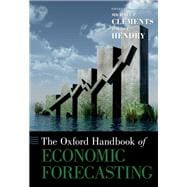
Note: Supplemental materials are not guaranteed with Rental or Used book purchases.
Purchase Benefits
What is included with this book?
| Contributors | p. vii |
| Introduction | p. 1 |
| Forecasting Models and Methods | |
| VARs, Cointegration, and Common Cycle Restrictions | p. 9 |
| Dynamic Factor Models | p. 35 |
| Forecasting with Nonlinear Time Series Models | p. 61 |
| Forecasting with DSGE Models | p. 89 |
| Forecasting Economic Time Series Using Unobserved Components Time Series Models | p. 129 |
| Improving the Role of Judgment in Economic Forecasting | p. 163 |
| Data Issues | |
| Nowcasting | p. 193 |
| Forecasting with Mixed-Frequency Data | p. 225 |
| Forecasting with Real-Time Data Vintages | p. 247 |
| Forecasting and Structural Breaks | |
| Forecasting From Misspecified Models in the Presence of Unanticipated Location Shifts | p. 271 |
| Forecasting Breaks and Forecasting During Breaks | p. 315 |
| Forecast Combinations | p. 355 |
| Forecast Evaluation | |
| Multiple Forecast Model Evaluation | p. 391 |
| Testing for Unconditional Predictive Ability | p. 415 |
| Testing Conditional Predictive Ability | p. 441 |
| Interpreting and Combining Heterogeneous Survey Forecasts | p. 457 |
| Analyzing Three-Dimensional Panel Data of Forecasts | p. 473 |
| Financial Forecasting | |
| Forecasting Financial Time Series | p. 499 |
| Forecasting Volatility Using High-Frequency Data | p. 525 |
| Special Interest Areas | |
| Economic Value of Weather and Climate Forecasts | p. 559 |
| Long-Horizon Growth Forecasting and Demography | p. 585 |
| Forecasting the Energy Markets | p. 607 |
| Models for Health Care | p. 625 |
| Election Forecasting | p. 655 |
| Marketing and Sales | p. 673 |
| Index | p. 691 |
| Table of Contents provided by Ingram. All Rights Reserved. |
The New copy of this book will include any supplemental materials advertised. Please check the title of the book to determine if it should include any access cards, study guides, lab manuals, CDs, etc.
The Used, Rental and eBook copies of this book are not guaranteed to include any supplemental materials. Typically, only the book itself is included. This is true even if the title states it includes any access cards, study guides, lab manuals, CDs, etc.